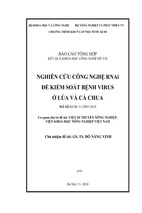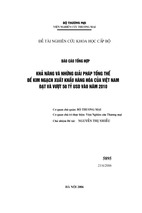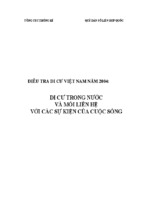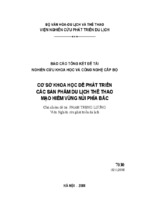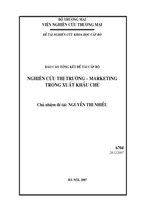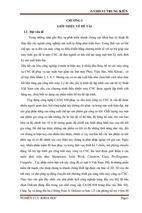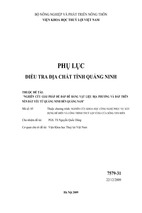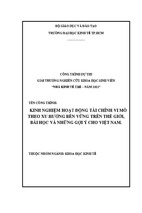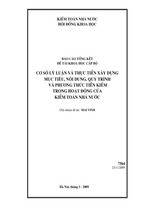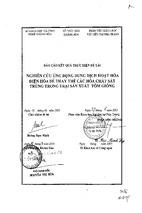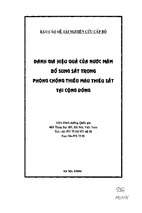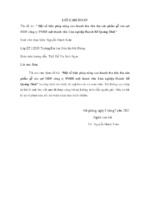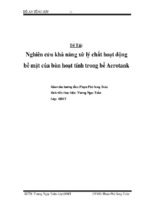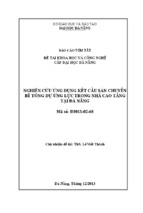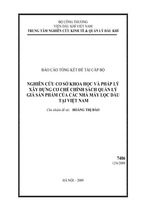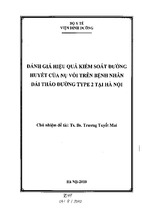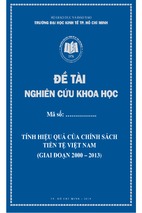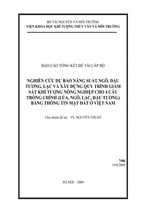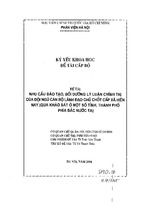FULBRIGHT ECONOMICS TEACHING PROGRAM
October, 2015
D O T H I E N A N H T U A N 1 (
[email protected])
C A O H A O T H I 2 (
[email protected])
RECOGNIZING THE ROLE OF FDI AND THE REQUIREMENT
OF INSTITUTIONAL REFORM IN VIETNAM
1
2
Fulbright Economics Teaching Program in Vietnam, (+84) 977687968
Saigon Technology University, Vietnam, (+84) 913969384.
Recognizing The Role Of Fdi And The Requirement Of Institutional Reform In Vietnam
Tóm tắt
Tưởng rằng gia nhập WTO sẽ có thể chắp thêm cánh cho kinh tế Việt Nam bay cao hơn nhưng thực tế lại
không như mọi người kỳ vọng. Từ năm 2007 đến nay kinh tế Việt Nam liên tục đối mặt với tình trạng bất
ổn vĩ mô, nhiều yếu kém của nền sản xuất nội địa bắt đầu bộc lộ. Trong khi các cỗ máy của tăng trưởng
kinh tế trong nước như SOEs và doanh nghiệp nội địa gần như ngưng trệ thì doanh nghiệp FDI vẫn duy
trì sức tăng trưởng của mình và tiếp tục có những đóng góp quan trọng cho kinh tế Việt Nam. Nghiên
cứu của FETP (2013) chỉ ra những nút thắt thể chế đã khiến cho khu vực FDI không có động cơ tham gia
vào các mắt xích của nền sản xuất nội địa nhưng cũng chính nhờ đó mà khu vực FDI gần như miễn
nhiễm khỏi các trục trặc của nền kinh tế trong nước. Thừa nhận các yếu kém về mặt thể chế đang gây trở
ngại cho phát triển kinh tế, Chính phủ Việt Nam đang thực hiện nhiều biện pháp nhằm cải cách thể chế
nhưng đồng thời cũng nhìn nhận lại vai trò của FDI trong giai đoạn phát triển sắp tới của Việt Nam. Bài
viết này sẽ trình bày khái lược về tình hình thu hút FDI ở Việt Nam kể từ khi Việt Nam thực hiện chiến
lược đổi mới kinh tế năm 1986 theo mô hình kinh tế mở và hội nhập. Bài viết cũng phân tích những đóng
góp của FDI đối với kinh tế Việt Nam, đồng thời chỉ ra những bất cập và hạn chế trong chiến lược hơn 25
năm thu hút FDI của Việt Nam. Cuối cùng, bài viết cũng sẽ phân tích những tranh luận gần đây trong
giới học giả cũng như các nhà hoạch định chính sách Việt Nam về vai trò của FDI trong bối cảnh Việt
Nam đang thực hiện chiến lực tái cơ cấu kinh tế gắn với mô hình tăng trưởng mới, đặc biệt là giai đoạn
chuẩn bị tham gia TPP.
Abstract
It was expected that upon the inception of the World Trade Organization (WTO) that Vietnam’s economy
would sprout wings and soar to unexpected heights, but in all reality it was a disappointment. Since 2007,
Vietnam’s economy has faced several challenges that rumbled the macro stability and revealed the
weaknesses of the real domestic sector. While local growth engines like State Owned Enterprises (SOE)
and domestic firms were stagnant, the Foreign Direct Investment (FDI) sector maintained its growth
momentum and continued to make important contributions to Vietnam’s economy. According to a
Fullbright Economics Teaching Program (FETP) study in 2013, there are institutional bottlenecks that
discouraged the FDI sector to participate in the local production chain and unexpectedly immunized
them from problems of the domestic economy. With respect to institutional weaknesses, as barriers to
economic growth, the Vietnamese Government has implemented measures to reform these institutions
and reviewed the role of FDI in Vietnam’s next phase of development. In this report, I will briefly
describe the FDI policy of Vietnam since Doi Moi (or Innovation) in 1986 toward an open and integrated
economy. Further, I will analyze FDI contributions to the economy and show the problems and
limitations of the last 25-years of FDI policy implementation. Lastly, this report will explore recent
debates among academia and policy makers in Vietnam about the role of FDI as Vietnam attempts to
restructure the economy and introduce a new growth model while finalizing Trans-Pacific Partnership
(TPP) negotiations in the near future.
Keywords: FDI, Vietnam economy, capital inflows, institutional reform, FDI from Taiwan
Page 2/29
Recognizing The Role Of Fdi And The Requirement Of Institutional Reform In Vietnam
1.
Introduction
Vietnam’s economic story begins in 1986 when Vietnam began implementing innovative policies and
economic integration. In its earliest stages, the foreign investment sector was identified as one of the most
important economic sectors in Vietnam’s economy and contributed to the success of strategic
industrialization and modernization undertaken by the Vietnamese Government. These innovative ideas,
policies, and incentiveswere applied by the government at both the central and local levels to attract
foreign investment. Nearly thirty years later, Vietnam has attracted more FDI than many other countries
in the region in terms of Gross Domestic Product (GDP) percentage -- far exceeding Thailand, Indonesia,
India, and even China. The cumulative foreign capital to GDP in Vietnam is much higher than those in
other countries in the region, including China. Some studies show that FDI has made important
contributions to Vietnam’s economy in many aspects, such as complementary domestic savings, growth,
economic structural change, improvement in the investment climate, strengthening of state governance,
promotion of industrial policy, enhancement of national competitiveness, contributions to exports and
revenues, job creation and improvement of salaries, etc. In addition to this success, further studies point
out the inadequacies and limitations of FDI in Vietnam. These inadequacies and limitations include the
fact that the majority of foreign enterprises employs only unskilled labor, engage in national resource
extraction, uses outdated technology, contributes to environmental pollution, primarily uses imported
resources, produces a low added value, provides poor spillover effects on domestic production,
succumbs to restrictions on the Transfer of Technology (TOT), and so on.
Especially in recent years, while Vietnam’s economy has begun to fall into attenuation of economic
growth and macroeconomic instability, the inadequacies and weaknessess of the domestic economy also
unfold. Among the weaknessess I have pointed out, the biggest weakness is the economic institution.
Through many years of innovation, the foundation of economic institution in Vietnam has not changed
much - especially in terms of thinking. State economy and state ownership are and continue to be key
roles in which SOEs are chosen as the leader of the economy despite the poor growth performance of this
sector. Many analysts argue that the institutional bottlenecks, which not only hamper Vietnam’s
economic growth, but also reduces the potential contribution of the FDI on the domestic economy are
responsible. Although, the Vietnamese Government has recognized these problems and is implementing
economic reform policies in which institutional reform is considered as a breakthrough. The success of
institutional reform will not only help create a new impetus for economic growth, but also to encourage
foreign investors consider domestic production of products, participate in global production value
chains, and mount the domestic production chain into the global production system.
2.
A glance at Vietnam’s macro-economic context
Vietnam’s economy has achieved growth of 9-percent or more, but that was the story of the mid-1990s. In
the years prior to joining the WTO, Vietnam’s economy showed signs of acceleration in which growth
was very high - as much as 8 - 8.5-percent - until officially joining the WTO in 2007. However, Vietnam’s
economy in fact did not take off as people expected. After reaching a peak growth in 2007, the economy
began to decline and continued to plunge since then. Economic growth in Vietnam is always associated
with the tale of high inflation. Obviously, this is not a new story, because it has been talked about in
economic textbooks - this is a big challenge for Vietnam with respect to policy management. From 2007 to
the present, the Government of Vietnam has repeatedly switched between the priority objective of
Page 3/29
Recognizing The Role Of Fdi And The Requirement Of Institutional Reform In Vietnam
growth and inflation control. This change in policy objectives will certainly affect the business
environment of enterprises in Vietnam - domestic investors as well as foreign investors.
Figure 1: GDP growth and inflation in Vietnam
Source: GSO of Vietnam
In addition to inflation, the macroeconomic instability in Vietnam is also manifested in the severe trade
deficit and enormous pressure on the devaluation of currency. The trade deficit has connotations that
domestic savings are not enough to finance investment, but it also means that the competitiveness of
Vietnam’s economy is poor. As will be discussed later, foreign investment has partially improved
Vietnam’s export capacity, but it still does not fully compensate for the weakness of the domestic
economy. The trade deficit has been financed mainly from foreign capital inflow. Unfortunately, the huge
capital inflow has directly caused turmoil in Vietnam’s financial markets. The Government of Vietnam
has not had much experience in managing the flow of international capital while the openness of
Vietnam’s capital account increased significantly after joining the WTO. More than 9-billion US dollars
poured into Vietnam’s economy in the first half of 2007, this posed a huge challenge for monetary policy
while Vietnam pursued a fixed exchange rate. Economists call this situation as a trilemma or an
impossible trinity. Meanwhile the sterilization policy of the State Bank of Vietnam (SBV) was not effective
when it could not sterilize the money supply and thus, inadvertently pushed the inflation rate to a very
high level in 2007.
Page 4/29
Recognizing The Role Of Fdi And The Requirement Of Institutional Reform In Vietnam
Figure 2: Trade Balance of Vietnam
Source: GSO of Vietnam
In addition to the trade deficit, the problems of the public sector such as budget deficits and the increase
in public debt also exhibited a direct push on Vietnam’s economy and yielded difficulties and
uncertainties. The budget deficit of the Vietnamese Government has always been maintained at a very
high level of 4 – 5-percent per year and this endured for a very long time. This has lifted the public debt
which is currently equivalent to 60-percent of the GDP. The cause of the high budget deficit in Vietnam is
partly due to budgetary discipline which is very loose. The mechanism of a soft budget constraint also
raises a moral hazard in the public agencies that are funded by the national budget (Do Thien Anh Tuan
2014a). Moreover, the increase in Vietnam’s public debt is also due to the Government’s loans to finance
public investment projects, but the efficiency is very low. SOEs also borrow money from banks, especially
from the state-owned banks, to invest in a variety of projects and these loans are usually guaranteed by
the Vietnamese Government. Meanwhile most SOEs have exhibited poor financial performance. After all,
almost all of the international government bonds were transferred to the state business corporations, but
the inefficient performance of these corporations has put a burden of debt on the Government’s budget.
A typical example is the bond debt worth US $750-million that the Government borrowed on the
international bond market in 2005 and then lent it to Vinashin – a shipbuilding corporation of Vietnam –
eventually this corporation was unable to repay the debt which led to a decline in Vietnam’s credibility
on the international capital markets.
Page 5/29
Recognizing The Role Of Fdi And The Requirement Of Institutional Reform In Vietnam
Figure 3: Budget deficit and public debt in Vietnam (% of GDP)
Source: MOF
Along with the weakness of the public sector, the Vietnam financial system also began staggering with
difficulties - in particular the banking system. After a period of explosive growth in credit – as much as
30-percent to 50-percent in some years - credit growth has started to decline even though the rate of
domestic credit to GDP in Vietnam has reached over 100-percent of GDP and has surpassed many
countries in the region. Severe bad debts have pushed many banks in Vietnam to fall into serious
financial difficulties. Meanwhile, the economic downturn also hindered the resolution of Non-performing
Loans (NPLs) and the ability to restore stability of the balance sheets of banks (Do Thien Anh Tuan
2014a). The freezing of the real estate market and stock market also created its own difficulties, which in
turn had an impact on the banking sector. A large amount of credit previously went into the real estate
sector, but the freezing of the real estate market also placed a burden of liquidation on banks.
Nevertheless, the situation of complex cross-ownership in Vietnam’s banking system has caused the
ineffectiveness of regulations on banking supervision of the SBV (FETP 2014).
The above analysis partially explains that, perhaps never, since the crisis of the mid-1980s, Vietnam’s
economy has fallen again into serious and prolonged instability as it has over the most recent past.
Weakenesses of the old-style growth model, which is based on incremental invested capital, has not
helped Vietnam in achieving higher growth. The Solow growth model seems to accurately predict the
case of Vietnam - of course, this is just a hypothesis. So far, the Vietnamese Government has recognized
the problems and has also developed and implemented projects to repair the economy, but the process is
still very low compared to the requirements and expectations of many people for having various
obstacles. It seems that the obstacles from the inside are significant enough that reform is almost at a
standstill. The Government of Vietnam is currently negotiating to join the Agreement on the TPP and
many people expect this Agreement will be a boost for Vietnam to promote reform.
Page 6/29
Recognizing The Role Of Fdi And The Requirement Of Institutional Reform In Vietnam
Figure 4: Domestic Credit to GDP
Source: EIU
However, the question is how the TPP Agreement impact to Vietnam’s economy is now still a debate
among Vietnamese scholars and policy makers. Lessons learned from the WTO inclusion are certainly
very valuable to businesses as well as the economic management agencies in Vietnam. As indicated,
Vietnam’s economy not only did not take off after joining the WTO, but it also faced many complex
challenges. Joining the TPP may create similar or larger challenges. The big question here is whether a
dose of the TPP is strong enough for the Vietnamese Government to discover the challenges and consider
those as a driving force for economic reform at this time.
3.
The process of opening up and attracting FDI in Vietnam
3.1. The period after Renovation of 1986 to the pre-Asian crisis in 1997
Vietnam has experienced almost 30 years of economic renovation and it has also been approximately that
many years since the Government of Vietnam issued the first version of the Foreign Investment Law
(FIL), which marked the establishment and integration of Vietnam into the world economy. During that
time, policies to attract foreign investment into Vietnam have undergone positive changes which resulted
in a wave of FDI flow into Vietnam in the context of the national and international economy. Figure 5
shows the process of attracting FDI into Vietnam for the period of 1988-2013. Only two years after the FIL
was enacted, there were more than 200 foreign investment projects registered with a capital of over US
$1.6-billion. This figure is not large in terms of absolute value, but when compared to the size of the
economy in 1990 the ratio is equivalent to 25-percent which is quite impressive. Obviously, this was a
success beyond expectations because in that context Vietnam’s economy was facing many difficulties,
inside was the macroeconomic instability and high inflation and outside was the collapse of COMECON
along with the collapse of the socialist model in the Soviet Union and the Eastern European countries.
Also during this period, there were economic sanctions imposed by the U.S. Government on Vietnam
since reunification in 1975. During the period from 1992 to 1997, Vietnam’s economy grew consistently
very high, averaging nearly 8.8-percent each year. Even in the two years of 1995 and 1996, the growth rate
Page 7/29
Recognizing The Role Of Fdi And The Requirement Of Institutional Reform In Vietnam
peaked at 9.54-percent and 9.34-percent, respectively. This result is partly due to policies unleashed in the
private sector after a long time of constraint, but another part is the role of the foreign investment sector –
which is like a catalyst for the reform of the business environment and the dynamics of competition for
domestic businesses, as well as for the SOEs. The year 1995 was also a time when the United States and
Vietnam declared normalization of diplomatic relations. This milestone not only marked a new phase in
the history of relations between Vietnam and the U.S., but more importantly, it opened a new stage in the
process of economic integration in Vietnam, to facilitate and attract more foreign investors throughout
the world into Vietnam. FDI continued to flow into Vietnam in the following years and peaked in 1996
with a total registered capital of over US $9.6-billion before the start of a slowdown since 1997 when East
Asian economies fell into crisis.
Figure 5: FDI flows into Vietnam period 1988 - 2013
Source: Vietnam General Statistics Office
3.2. The period after the East Asian crisis until before joining the WTO
Until the mid-1990s, Vietnam’s economy had not yet fully integrated into the world economy, but the
impact of the Asian financial crisis in 1997 on the economy of Vietnam was very clear, if we look at the
decline of inflows of FDI. This period of decline lasted until 1999 when the amount of registered capital
was just US $2.3-billion - equivalent to that of 1992. Not only the registered capital, but also the number of
foreign projects decreased as well. The number of foreign projects, after peaking in 1995 with 415 projects,
fell back to only 285 projects in 1998. In addition to the impact of the Asian crisis, the amendments to the
Law on Foreign Investment in 1996 could also be a cause of the decline of foreign investment inflows into
Vietnam during this period. This is because the amended FIL has reduced the incentives for foreign
investors. Since 1999, the number of foreign investment projects began to increase rapidly, but the
registered capital has almost not improved significantly. This situation maintained itself until 2006 when
Vietnam was preparing to join the WTO. There was a notable point in attracting FDI in Vietnam during
this period that the registered capital experienced greater volatility than the disbursement capital. This is
true for both periods before and after the Asian crisis. There were even a number of years, while the
Page 8/29
Recognizing The Role Of Fdi And The Requirement Of Institutional Reform In Vietnam
registered capital declined, in which the disbursement capital increased. This suggests that many foreign
investors in Vietnam, in this period, were not affected much from the crisis or the continued
disbursement of foreign capital and also showed that Vietnam was not affected much from this crisis.
This has contributed to maintaining the trust and the growth rate for Vietnam’s economy even during the
economic crisis.
Figure 6: GDP growth and CPI inflation in Vietnam period 1988 - 2014
Source: Vietnam General Statistics Office
The recovery process of FDI in Vietnam took place simultaneously and at the same pace with the
recovery of Vietnam’s economy during the period 1999-2006. Figure 6 shows that Vietnam’s economy
declined sharply in 1999, but has recovered at a reasonable pace before joining to the WTO at the end of
2006. Both the number of projects and the registered capital accelerated in 2006, signaling a new boom of
FDI as had occurred in the later years of innovation. Despite this, registered capital and the number of
projects simultaneously tended to increase, but the disbursements did not increase significantly.
Although this means that many foreign investors have begun to expect a brighter future for Vietnam’s
economy, an all-clear signal to realize investment opportunities in Vietnam has not yet transpired.
Vietnam becoming the 150th member of the WTO in late 2006 officially transmitted a positive signal to the
expectation of the international investment community.
3.3. The post-WTO period to the present
While it is difficult to describe all the excitement of the businesses and the investors when Vietnam
officially joined the WTO, foreign investment capital started pouring into Vietnam - especially in the
second half of 2006. Although the number of projects did not spike compared with the previous year, the
registered capital continuously increased from US $6- billion in 2005 to more than US $12-billion in 2006,
then US $21-billion in 2007, and peaked at US $71.7-billion in 2008, equivalent to 80-percent of the GDP of
Vietnam in 2008. Although the actual disbursement of capital was lower than the registered capital, it
Page 9/29
Recognizing The Role Of Fdi And The Requirement Of Institutional Reform In Vietnam
increased sharply compared with the previous period. The total value of FDI disbursed reached more
than US $8-billion in 2007, rose to US $11.5-billion in 2008 and maintained at approximately US $10billion to 11-billion per year to date even when the registered capital began, and continued to decrease in
and since 2009.
The decline of registered FDI into Vietnam is partly due to the high growth of FDI inflows in the initial
years of the post-WTO era. Since 2009, even the registered capital has had a tendency to decline, but it
still remains at a higher level than the period before WTO accession. Otherwise, the drop of FDI
registered during this period is part of the reason that many foreign investors are affected by the
economic crisis, which is considered the worst since the Great Depression 1929-1933. This reason may be
true in part because the rate of disbursement to registered capital in this period is quite low, only 35percent, just half of the rate during the period before WTO accession. However, the actual funds
disbursed in this period are very large compared to the scale and the absorption capacity of Vietnam’s
economy in a short amount of time. This does not take into account the huge amount of Foreign Indirect
Investment (FII) that poured into Vietnam during this period, which is estimated by the SBV to be as
much as US $6.25-billion. In addition to the investment capital flows, other flows such as remittances and
official aids also increased sharply during this period. When capital flows into a country it will pose
many challenges for policymakers to stabilize and manage the macro economy. In Vietnam, the exchange
rate mechanism is maintained almost constant by the SBV. In the context of free capital flows, it will make
monetary policy ineffective. This is the challenge of the impossible trinity situation that Vietnam’s
policymakers have actually faced during this period. As shown in Figure 6, the high inflation rate flared
up again when the SBV was unable to sterilize a huge amount of the money supply that this agency had
pumped out to buy a large amount of foreign reserves in order to prevent the appreciation of the
currency.
Fortunately, many foreign investment projects continued to rise steadily while Vietnam’s economy fell
into turmoil and the many weaknesses of the domestic economy began to emerge. This suggests that
foreign investors do not pay much attention to the weaknesses of Vietnam’s domestic economy. This
assertion may incite controversy because the problems of the economy will inevitably affect the
investment climate and the competitiveness of businesses (particularly foreign enterprises) in general.
However, as many studies have shown,3 this still may be true in the context of Vietnam as the
institutional weaknesses have led to a lack of incentives for many foreign businesses to mount their
operations into the domestic production system. In other words, the links in business activities of foreign
and domestic firms are very loose and the limited application of Vietnam’s institutional provisions on
foreign firms “granted” immunity from the weaknesses of domestic institutions. This fact poses new
challenges for the Vietnamese Government to recognize the role of FDI in Vietnam, as well as the
requirements for institutional reforms aiming not only at attracting FDI to be more compatible with the
goal of economic development, but also create new momentum for sustainable economic growth in the
future.
3
See FETP/VELP 2013.
Page 10/29
Recognizing The Role Of Fdi And The Requirement Of Institutional Reform In Vietnam
4.
Some characteristics of FDI in Vietnam
4.1. Scale of projects
By the end of 2013, Vietnam has attracted nearly 16,000 foreign investment projects with a total registered
capital of US $234-billion. But on average, the size of an FDI project in Vietnam is relatively small. Most
foreign investors to Vietnam are mainly small and medium-scale enterprises coming from countries in
the region. Over a span of 23 years (1991-2013), the average registered capital of one project is
approximately US $14-million. If it is calculated separately for the actual disbursement, the size of one
project is much smaller - approximately US $6-million. The average scale of projects varies over time,
especially before and after an economic crisis.
Figure 7: Scale of projects
Source: Calculated from database of Vietnam General Statistics Office
Prior to the East Asian Crisis, 1991-1997, the average capital scale of one foreign project had increased
from US $3-million to US $9-million. The scale of projects began to decline during the recession - down to
an average of approximately US $3.5-million a project - and continued plummet until 2005. After joining
the WTO, project size began to increase and peaked in 2008 at US $10-million a project if calculated based
on disbursement or US $61-million based on registered capital. The scale of foreign projects has had a
tendancy to backslide slightly from 2009, reaching an average of about US $7.5-million a project.
4.2. Partners
Foreign investors in Vietnam come from many countries around the world with the most coming from
the Asian countries of Japan, Korea, Taiwan, Singapore, Malaysia, China, etc. with a registered capital
accounting for 70-percent of the total foreign direct investment capital. By the end of 2013, Japan was the
largest foreign investor in Vietnam with an accumulative registered capital of over US $35-billion.
Following Japan are Singapore (US $30-billion), Korea (US $29.6-billion), and Taiwan (US $28-billion).
Although the total number of partners have invested in Vietnam is now greater than 100 countries and
territories. However, there is a very high focus on a certain group of countries, particularly the countries
Page 11/29
Recognizing The Role Of Fdi And The Requirement Of Institutional Reform In Vietnam
in the Asian region. Only ten leading countries investing in Vietnam have accounted for 80-percent of the
total registered capital. This figure has virtually remained unchanged for more than two decades of
attracting FDI in Vietnam. If calculated according to the number of projects, Korea, followed by Taiwan,
Japan, and Singapore are the largest investors. These are also the top four countries that have invested the
most in Vietnam. However, if calculated according to the average capital size of a project, these countries
do not appear on the list. Instead, the British West Indies, Cayman Islands, Cyprus, and Luxembourg are
the territories that have the largest project in terms of average capital scale. The average size of a project
amongst all investors, coming from the U.S. or Euopean Union (EU) such as Germany, England, or
France, is not too high if not lower than that of the investors from the Asian region.
Figure 8: Foreign Investment by Partners
Source: Vietnam General Statistics Office
4.3. Form of ownership
There are many diffirent forms of ownership in the foreign invested enterprises in Vietnam, of which the
most common are joint stock ventures and 100-percent foreign owned. other forms of ownership include
business cooperation contracts and joint stock corporations. By the end of 2013, nearly 80-percent of all
foreign projects organized were in the form of 100-percent foreign ownership, followed by joint stock
ventures, accounting for 17.5-percent, and the remaining fractions are other forms of ownership. Foreign
investment projects have changed significantly over time. Initially, due to myriad obstacles and various
conditions, the FIL did not encourage investors to establish enterprises in the form of 100-percent foreign
capital; instead the form of a joint stock venture between SOEs and foreign investors was very popular.
Not until the mid-1990s, did the number of projects in the form of joint stock ventures account for 57.5percent of total projects invested in Vietnam - only 38-percent of those projects were 100-percent owned
by foreigners. Since 1997, after an amendment of the Law on Foreign Investment, limitations on
ownership for foreign investors were gradually suspended. The form of ownership in the FDI projects
also began to change dramatically. Up until the early 2000s, 100-percent foreign ownership had
Page 12/29
Recognizing The Role Of Fdi And The Requirement Of Institutional Reform In Vietnam
accounted for nearly 64-percent of total FDI projects invested in Vietnam, while the number of joint stock
venture projects had fallen to 29-percent. This propensity of shifting has continued until today.
Figure 9: Form of Ownership of FDI Projects
Source: Vietnam’s Ministry of Planning and Investment
4.4. Field of Investment
FDI projects in Vietnam are spread across many fields and sectors ranging from agriculture to industry
and services in which the number of registered projects in the field of manufacturing and processing
industry has always accounted for the largest portion. The total number of projects in the field of
manufacturing and processing industry accounted for nearly 55-percent of total projects and 54-percent
of total registered capital by the end of 2013. The FDI capital primarily invested in the area of
manufacturing and processing is essentially consistent with the direction of the industrialization policy in
Vietnam. Although it is unlikely to generate a boom in Vietnamese Industry, it will at least contribute to
the shifting of the economic structure of Vietnam towards industrialization. In the 1990s, FDI capital was
primarily directed to the mining industry and import substituted sectors, however, many FDI projects are
now strongly redirected to the manufacturing and processing industries and the export-oriented sectors.
Considering that in some ways this shift is positive. FDEs have contributed significantly to the annual
export turnover with the contribution ratio at approximately 60-percent to 65-percent of the total exports
of the entire economy.
While the amount of capital registered in the industrial sector in general - manufacturing and processing
sector in particular - tends to increase, the amount of FDI capital in the agricultural sector tends to
decrease. Projects invested in agriculture, forestry and fisheries by the end of 2013 have accounted for
only 3.1-percent of total foreign projects and 1.4-percent of the total foreign registered capital -significantly lower than the corresponding rate of 17.3-percent and 8-percent in the mid-1990s and 8.8percent and 5.6-percent in the mid-2000s. Foreign investment projects in the real estate area have
increased dramatically since joining the WTO. There are currently over 400 FDI projects in the area of real
estate business, accounting for approximately 2.6-percent of total projects, but the amount of registered
Page 13/29
Recognizing The Role Of Fdi And The Requirement Of Institutional Reform In Vietnam
capital accounts for only 21-percent of the total cumulative registered capital by the end of 2013 equivalent to more than US $49-billion.
Although FDI capital primarily flows into the manufacturing and processing sectors, the average capital
size of one project is relatively small at approximately US $14.4-million. The average size of one project in
the agricultural sector is much lower at only US $6.7-million. Meanwhile, the registered capital of one
foreign real estate project is more than US $120-million. Similarly, mining projects have an average capital
of US $40-million per project; the projects in other industries such as production and distribution of
electricity, gas, etc. have an average capital of more than US $100-million each project.
4.5. Investment location
All localities in Vietnam have attracted FDI capital, but capital distribution is uneven. FDI is mainly
concentrated in some regions with better conditions of infrastructure, skilled labor, and a good business
environment. By the end of 2013, Ho Chi Minh City, Ba Ria – Vung Tau, Ha Noi, Dong Nai, and Binh
Duong are the top five provinces attracting the most FDI capital in Vietnam. These five localities have
attracted more than 50-percent of the total FDI capital in the country. In recent years, the distribution of
FDI was more balanced. Many other provinces have strongly emerged, increased their investments in
infrastructure and implemented the best preferential policies to attract big investors throughout the
world. It is the dynamic of these localities that has made them appealing to big investors in attracting
FDI. It is no longer the exclusive playground of traditional localities. Although not entirely true for all
localities, especially localities in the Northwest, the Central Highlands, and the Mekong Delta, FDI capital
has a more harmonious distribution among localities. Many localities have been racing to build industrial
parks and compete with each other in various ways to fill up those parks. Many localities, however, due
to poor planning and planning not based on any particular competitive advantages; rely heavily on the
preferences of land, taxes, and infrastructure. Consequently, many industrial parks have been established
and then abandoned. Unhealthy competition policies among localities have accidentally pushed all
localities to fail altogether into situations of disadvantage and cause damage to the overall benefit of the
economy (Vu Thanh Tu Anh 2006).
4.6. Attracting large international corporations
As previously discussed, the majority of foreign investors to Vietnam are small and medium enterprises
coming from surrounding Asian countries. Apparently, small enterprises have their own advantages, but
generally small scale companies might face many disadvantages in the competition, especially when they
want to reach out and join the world economy. Vietnam is now trying to attach its domestic production
chain to the value chain of the global production system. To achieve this goal, the role of transnational
corporations is very important. These corporations are expected to not only help domestic enterprises
access the global market, but also help to create momentum for economic reform and stronger
competition, even in the domestic market.
For a long time after opening the economy and attracting FDI, Vietnam continues to lack world-class
investors. In the most recent decades, the active participation in trade and investment agreements with
many countries has created many opportunities for Vietnam in attracting the world’s largest
corporations. So far, Vietnam has attracted over 100 out of more than 500 of the world’s leading
transnational corporations. Many of the leading corporations in the world such as BP, Total, Intel,
Unilever, Coca-Cola, Pepsi, Samsung, Nokia, Toyota, and Canon have come to Vietnam which has
Page 14/29
Recognizing The Role Of Fdi And The Requirement Of Institutional Reform In Vietnam
provided opportunities for Vietnam to upgrade the value chain of the domestic production system. Can
Vietnam be successful or not? The answer depends on many factors of which the most important thing is
the capacity of domestic firms. Whether these firms can be upgraded to keep pace with the demands of
global standards or not? Additionally, institutional reforms that encourage pursuing Vietnam is also
considered as a prerequisites. Because these reforms will not only help Vietnam attract more top foreign
investors, but more importantly, create a new growth engine for the domestic private sector. The
Vietnamese industrialization policy cannot be called successful if the game has only the world’s leading
corporations, but lacks domestic industrialists.
4.7. Taiwan’s direct investment in Vietnam
Investment of Taiwan enterprises in Vietnam
Taiwan is one of the most important ecnomic partners of Vietnam on various aspects from trade to
investment. Since opening up and attacting FDI to date, Taiwan is always among the top leading
countries and territories that have many projects invested in Vietnam. By the mid-1990s, Taiwan had a
total of 240 projects with a total registered capital of over US $3-billion, accounting for 17-percent of total
FDI capital in Vietnam - the leader of all the countries/territories that had investment projects in Vietnam.
By the mid-2000s, the total number of projects that Taiwan had invested in Vietnam exceeded 1,600
projects and accounted for 22-percent of total foreign projects with a total registered capital of US $8.6billion which accounted for 13-percent. Until the end of 2013, Taiwan continued to maintain its position
as one of the four largest foreign investors in Vietnam, just behind Japan, Singapore, and South Korea in
terms of registered capital. Up to now, the total number of Taiwanese enterprise projects invested in
Vietnam has risen to nearly 2,300 projects with a total registered capital exceeding US $28-billion, ranking
second only to South Korea which has invested in 3,600 projects in Vietnam. Investments of Taiwanese
enterprises is distributed throughout the most important economic sectors in Vietnam, including
agriculture, manufacturing and processing industries, mining, transportation, construction, hotels,
tourism, etc. As of the end of October 2014, Taiwanese enterprises have invested in 60 new projects and
increased capital in 44 operating projects with a total new capital investment of US $723.4-million and
now ranks 5th out of 56 countries and territories that have projects in Vietnam. Investments of Taiwanese
enterprises continue to focus on the manufacturing and processing sector. There are 40 new projects and
40 new capital projects with a new total of registered capital reaching US $670.5-million. Following this
are accommodations, food, and buildings. As for the agricultural sector, Taiwan is currently in the
leading position and more than 30 countries and territories have invested in Vietnam’s agricultural
sector.
Taiwan’s investment projects are now established in over 50 of Vietnam’s provinces, but are mainly
concentrated in the Southern provinces such as Ho Chi Minh City, Dong Nai, Binh Duong, and Long An.
In the first ten months of 2014, 24 provinces attracted investment from Taiwan, in which Ha Nam and
Dong Nai are the two provinces in the lead. Taiwanese firms employ about 100.000 direct workers and
tens of thousands of indirect workers.
Page 15/29
Recognizing The Role Of Fdi And The Requirement Of Institutional Reform In Vietnam
Figure 10: FDI from Taiwan compared with other countries/regions (US$ Million)
Source: Vietnam’s Ministry of Planning and Investment
Vietnam as a preferred destination for Taiwanese enterprises
According to the survey results of the Ministry of Economic Affairs of Taiwan, Vietnam remains an
important investment destination for Taiwanese enterprises in the next three years. In comparison with
China, Vietnam ranks behind by only three coastal economic zones of China, including Jiangsu,
Guangdong, and Shanghai. The motivation for choosing Vietnam as the investment destination of
Taiwanese enterprises focuses on the following four factors: (i) low labor costs; (ii) low land costs, tariff
references and other incentives; (iii) exploitation of the potential of markets; and (iv) meeting the
requirements of shift in the supply chain.
However, according to the survey on the Taiwanese enterprises in 2007 and 2011, the important and
priority position in the aforementioned factors have changed noticeably. Accordingly, while the low cost
of labor is still the leading factor in the decisions of Taiwanese firms, the cost of land and other incentives
has become a secondary factor.
In addition, the development potential of Vietnam’s domestic market is also an important factor for
Taiwanese businesses. In 2007, this factor was ranked at 4, but in 2011, the position improved to a ranking
2. This suggests that the shift to accessing Vietnam’s market is becoming clearer (IPCS 2012). The ability
to access natural resources is also an important engine in the investment decisions of Taiwanese
investors. After a disquieting event in the East Sea, Taiwanese businesses remain confident of Vietnam’s
investment environment. Investment flows from Taiwan in the near future will continue to pour into
Vietnam as a stable and reliable destination. The fields in which Taiwanese investors are now interested
in include insurance, medical equipment, electrical equipment, automotive parts, food, cosmetics, and
more.
5.
The role of FDI in the Vietnam’s economy
5.1. Additional investment capital for the economy
As a developing country, Vietnam needs huge investment for economic growth. Meanwhile, the scale of
domestic savings is often not sufficient even if the rate of savings in Vietnam is relatively high. Therefore,
Page 16/29
Recognizing The Role Of Fdi And The Requirement Of Institutional Reform In Vietnam
the attraction of foreign investment is also a way to supplement national savings and increase investment
capital for economic development in Vietnam. With that in mind, from very early on, the Vietnamese
Governments reform policies have focused on attracting international capital, with a special emphasis on
the role of FDI.
Figure 11: Gross National Savings and Investment of Vietnam (% of GDP)
Source: GSO of Vietnam
Figure 12 shows that the share of FDI capital in the total investment capital in the economy had reached
approximately 30-percent in the period before the East Asian Crisis in 1997. After the crisis, along with
private sector investment, the share of FDI capital began to decline similar to that period of time prior to
WTO induction in 2006. After joining the WTO, the FDI share increased rapidly to peak like the period
before the East Asian Crisis. The increase of FDI capital has coincided with the continuous growth of the
private sector in the economy, while the role of the state sector has continuously declined since the
beginning of the decade 2000. Currently the FDI sector is contributing more than one-fifth of the total
investment capital of the economy as a whole.
Figure 12: Investment Capital by Economic Sectors
Source: GSO of Vietnam
Page 17/29
Recognizing The Role Of Fdi And The Requirement Of Institutional Reform In Vietnam
5.2. Growth and the economic structure shift
Over the past decade, the FDI sector has always had the important contribution to GDP and GDP growth
in Vietnam. Futhermore, the contribution of the FDI sector tended to increase, though the contribution
proportion is still lower than that of the other two economic sectors. As Table 1 shows in the period 20012006, the FDI sector has contributed about 14.7-percent to the annual GDP of Vietnam, and increased to
17.6-percent in the period of 2007-2012. The contribution to the FDI sector to annual GDP growth was
even greater and accounted for about 15.6-percent in the period of 2001-2006 and increased to 21.2percent in the period of 2007-2012.
According to Dao Quang Thu (2013), FDI capital mainly focuses on the industrial and construction
sectors with proportion of 58.4-percent, in which the technogical level of foreign enterprises is higher
than the national average level. The growth rate of the industrial and construction sectors has reached an
average of 18-percent per year, higher than the average growth rate of the entire industry. Similarly, in
the agricultural sector, FDEs also contributed significantly to the trend of agricultural structure shift,
diversification of products, improvement of the export value of agricultural goods, improvement of
cultivation practices, absorption and application of advanced technologies in the field of agriculture,
improvement of agricultural infrastructure, etc. Finally, foreign investors also create a new face in
Vietnam’s service sector. High-quality services such as hotels, restaurants, offices for lease, finance,
banking, insurance, audit, legal services, shipping, logistics, supermarkets, etc. are increasingly attracting
more foreign investors to participate in them, thus contributing to creating a competitive environment for
businesses in the country while improving quality and service standards (Dao Quang Thu 2013).
Table 1: Overview of resource use and contributions of the three economic sectors
State Economic Sector
2001-2006
2007-2012
Non-State Economic
Sector
2001-2006
2007-2012
Foreign Economic
Sector
2001-2006
2007-2012
Resource use
Investment Capital
51.8%
37.4%
32.1%
36.8%
16.1%
25.7%
12.9
53.4
0.26
0.91
6.77
10.8
GDP
38.2%
34.0%
47.1%
48.4%
14.7%
17.6%
GDP Growth
Revenues (exclude oil) – of total
revenues
39.2%
27.6%
45.2%
51.2%
15.6%
21.2%
18.7%
17.9%
7.2%
10.7%
7.0%
11.1%
Jobs
11.8%
10.6%
86.3%
86.0%
1.9%
3.4%
Jobs Growth
8.4%
6.0%
77.8%
88.8%
13.8%
5.2%
Industrial Production Value
Industrial Production Value
Growth
Source: FETP’s calculation
27.6%
18.2%
29.2%
37.5%
43.0%
44.2%
25.7%
11.7%
35.7%
40.4%
38.6%
47.9%
Capital per enterprise (US$ mill.)
Contributions to the economy
5.3. Industrial policy
At an early age, after the adoption of the policy on innovation in 1986, the Vietnamese Government
embarked on the implementation of industrial policy. To date, Vietnam’s policy on industrialization has
been just going a short journey, and the next journey is still very long, difficult, and challenging. The risks
Page 18/29
Recognizing The Role Of Fdi And The Requirement Of Institutional Reform In Vietnam
of the industrialization policy of Vietnam are that it places its success or failure on the role of StateOwned Enterprises (SOEs). In fact, the role of SOEs as a driver of economic growth as well as
industrialization strategy in Vietnam has been proven to be failure (FETP 2013). Meanwhile, the role of
the private sector, so far, is still limited, although this sector is gradually revealing a more important role.
In contrast, the FDI sector has contributed greatly to the initial success of the industrialization policy in
Vietnam. As discussed above, FDI firms primarily invest in the industrial sector, thereby significantly
helping to improve production capacity and efficiency of the industry in Vietnam.
Figure 13: Industrial Production Value by Sectors (US$ billion)
Source: GSO of Vietnam
The data in Table 1 reveals that in the period 2007 – 2012, the FDI sector had contributed to more than
44.2-percent of the total value of industrial production, which appears to have increased significantly if it
is compared with the 43-percent of the 2001-2006 period. Meanwhile, the state sector and the non-state
sector had just contributed only 18.2-percent and 37.5-percent of the total value of industrial production
during the period 2007-2012, respectively. Particularly in 2013, the industrial production value that the
FDI sector generated is more than half of the total value of industrial production of the whole economy
(see Figure 13). The contribution to the growth of industrial production value of the FDI sector in the
period 2007-2012 was higher than that of the previous period and reached 48-percent, while the state
sector had accounted for 11.7-percent and the private sector accounted for 40.4-percent of the industrial
production growth value. The remarkable thing is the percentage contribution from the FDI sector is very
large, but the level of use of resources for this sector is the lowest compared with the other two sectors.
Table 1 shows that the proportion of FDI capital accounted for only 25.7-percent of the total investment
capital in the economy while the remaining two sectors, each accounted for approximately 37-percent of
the total capital.
5.4. Tax revenues and exports
The FDI sector has contributed significantly to the annual national budget revenues in Vietnam.
According to the Vietnam Ministry of Finance (MOF), in the early 2000s, FDEs had contributed
approximately 6 percent of total national budget revenues. By 2013, the budget contribution of FDI sector
Page 19/29
Recognizing The Role Of Fdi And The Requirement Of Institutional Reform In Vietnam
has reached to 15 percent. It should be noted that this figure is only calculated the direct contributions,
such as corporate income tax, value added tax, national resource tax, import and export tax, etc... but do
not included any other indirect contributions such as personal income tax of employees working in the
FDEs. In addition, these contributions are also excluded revenues from oil exports of the FDEs. However,
the contribution to the budget of the FDI sector is not too impressive compared to the other two economic
sectors. Part of the reason is because the FDEs receive a lot of tax incentives to invest in Vietnam. There is
also another reason that many FDEs have signs of transfer pricing, especially for multinational
enterprises.
Figure 14: Contribution of the FDEs on tax revenues and exports
Source: Vietnam GSO and MOF
In addition, the FDI sector has contributed significantly to the success of Vietnam’s exports, helping to
improve the status of trade balance and increasing foreign reserves. GSO’s figures show that in the mid1990s, the proportion of export value of the FDI sector had accounted for an average of 30-percent of the
total value of exports for the entire country. In recent years, while the economy fell into a recession and
the health of the domestic economic sectors became difficult, the FDI sector continued to hold the engine
of growth for Vietnam’s economy, particularly in the area of exports archievement (FETP 2013). In 2013,
the share of exports of FDEs increased 2.5 times compared with 20 years ago and is expected to grow in
the coming years.
5.5. Labor and employment
Economic growth and job creation are the top priority objectives of the Vietnamese Government. So far,
the Vietnamese Government has set the tasks for the public sector. In fact, the ability to create new jobs of
the SOEs is very low, but tends to decrease. Meanwhile, the current distribution of FDEs into the labor
market are relatively modest, only about 3.4-percent of the total labor force working annually during the
period 2007-2012, but this proportion significantly improved compared with the 1.9-percent of the period
2001-2006 and with 0.7-percent of the period of the mid-1990s. In 2013, the number of employees working
in the FDI sector was approximately 1.8-million and accounted for 3.4-percent of the total number of
employees working in all economic sectors.
Page 20/29



